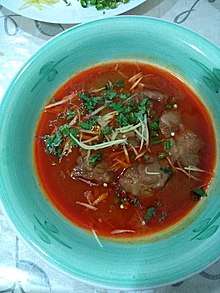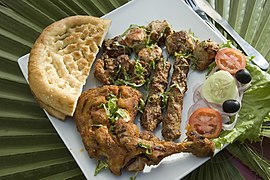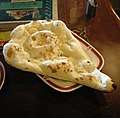Nihari
Nihari (Bengali: নিহারী, Hindi: निहारी, Urdu: نہاری) is a stew from the Indian subcontinent consisting of slow-cooked meat, mainly shank meat of beef or lamb and mutton, goat meat and chicken, along with bone marrow.
| Course | Breakfast, Lunch, Dinner |
|---|---|
| Place of origin | Indian subcontinent |
| Associated national cuisine | India, Bangladesh, Pakistan |
| Created by | Nawabs of the Mughal empire |
| Serving temperature | Hot |
| Main ingredients | Shank meat of beef, lamb and mutton, or goat meat, or Camel meat (mainly in Pakistan), also chicken |
| Other information | Served with bread (Naan) or rice |
Etymology
Nihari comes from the Urdu word nihar (نہار) which originated from the Arabic nahaar (نهار), meaning "morning". It was originally eaten by Nawabs in the Mughal Empire as a breakfast item after their Islamic morning prayer (salah) of Fajr. After a hearty breakfast of Nihari, the Nawabs would take a nap till afternoon, when they would wake up for afternoon prayers.[1]
History
Precursors
According to the Sushruta Samhita, lightly spiced meat broth using vida salt, zeera and asafoetida was highly rated in ancient India.[2]
Modern dish
According to many sources, Nihari either originated in Hyderabad or Old Delhi in the late 18th century during the last throes of the Mughal Empire or in the royal kitchens of Awadh, in modern-day Lucknow, Uttar Pradesh, India.[3]
Nihari developed with the overall cuisine of Muslims of the Indian subcontinent. It has been an old popular delicacy in parts of Bangladesh, particularly Dhaka and Chittagong. People cooked it for one whole night and they got it in the early morning at sunrise. The dish is known for its spiciness and taste. It was originally more of a delicacy with myriad variations on spiciness and texture.[4][5]
Popularity
Nihari is a traditional dish of Muslims of Delhi, Bhopal and Lucknow. After the creation of Pakistan in 1947, many Urdu speaking Muslims from northern India migrated to Karachi and Dhaka, and established restaurants. In Karachi, Nihari became a roaring success[6] and soon all over Pakistan. Now Nihari is available in Pakistani restaurants around the world.

In some restaurants, a few kilos from each day's leftover Nihari is added to the next day's pot. This re-used portion of Nihari is called taar and is believed to provide the unique flavor. Some Nihari outlets in old Delhi boast of an unbroken taar going back more than a century.[7]
Medication
Nihari is also used as a home remedy for fever, rhinorrhea and the common cold.[8]
See also
References
- Sengupta, Sushmita (3 January 2018). "Nihari: History Of The Meaty and Buttery Breakfast Staple of The Mughals". NDTV Food. Retrieved 3 January 2018.
- Achaya K. T. "Indian Food Tradition A Historical Companion". Retrieved 7 February 2019.
- "Nihari, a gift from Nawabs". The Times of India. Retrieved 5 March 2016.
- "Nahari". Retrieved 5 March 2016.
- "Nihari Recipe". Retrieved 5 March 2016.
- "Nihari a la Mexican style". The Hindu Business Line. Retrieved 5 March 2016.
- "Dilli Ka Dastarkhwan". Retrieved 28 November 2014.
- "What is Nihari?". Archived from the original on 19 December 2014. Retrieved 28 November 2014.



